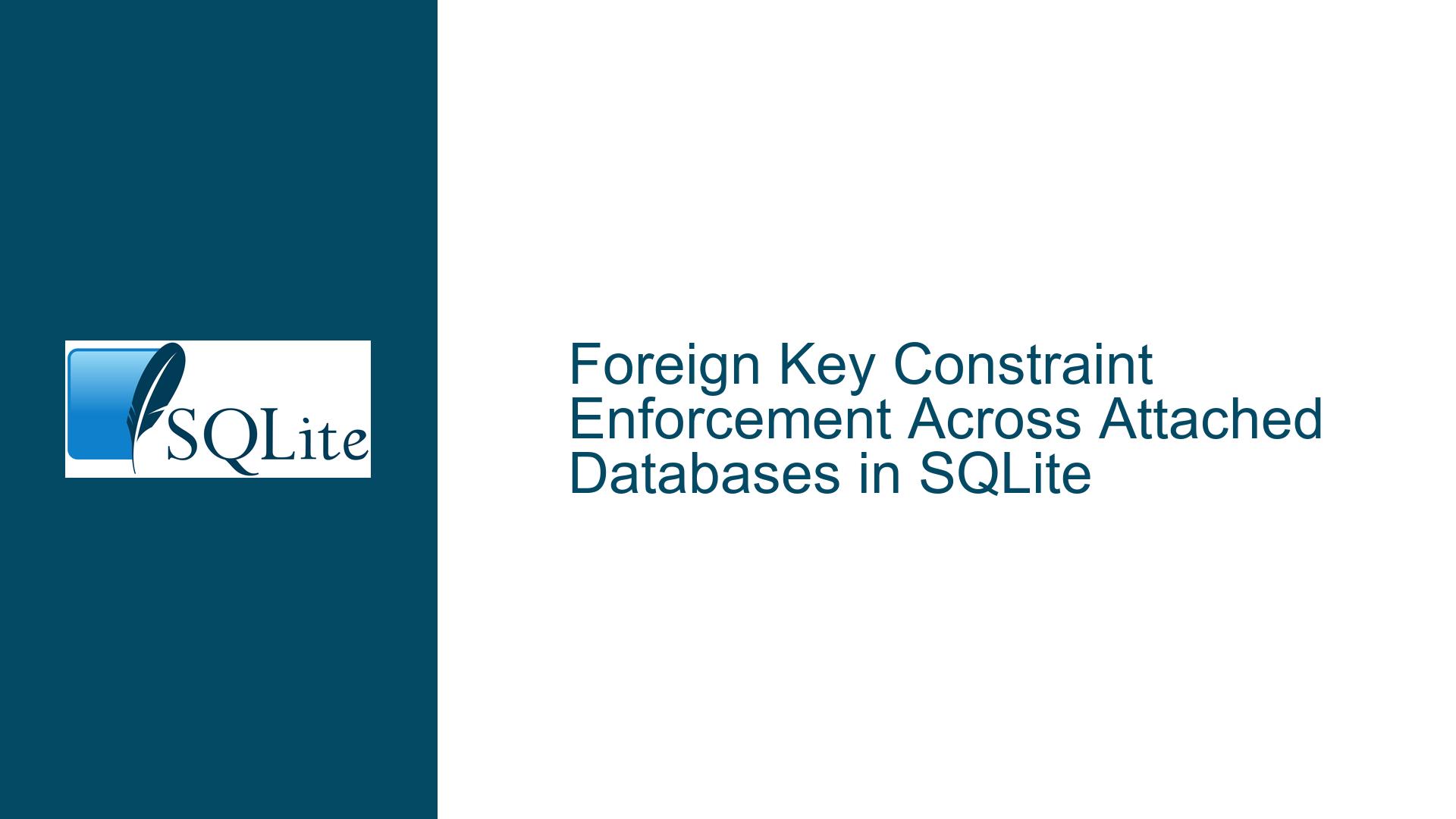Foreign Key Constraint Enforcement Across Attached Databases in SQLite
Understanding Foreign Key Enforcement Across Multiple Attached Databases
When working with SQLite, one of the most powerful features is the ability to attach multiple databases to a single connection. This allows for seamless querying and manipulation of data across different database files. However, this feature can introduce complexities, especially when dealing with foreign key constraints. The core issue arises when foreign key constraints are enforced across attached databases in a way that may not align with the developer’s expectations. This behavior can lead to unexpected foreign key constraint violations, particularly when tables with identical names exist in multiple attached databases.
To understand this issue, let’s first break down how SQLite handles foreign key constraints in the context of attached databases. When a database connection is established, and multiple databases are attached, SQLite treats them as a single logical database for the duration of the connection. This means that foreign key constraints are enforced across all attached databases, not just the main database. This behavior is by design, as SQLite’s foreign key enforcement is connection-wide. However, this can lead to confusion when tables with the same name exist in different attached databases, and foreign key constraints are enforced against the "wrong" database.
The problem becomes more pronounced when the order of attaching databases influences the enforcement of foreign key constraints. SQLite uses a "least recently attached" precedence when resolving table names without a database prefix. This means that if you have tables with the same name in multiple attached databases, SQLite may resolve the table reference to the database that was attached last, rather than the one you intended. This can result in foreign key constraints being enforced against a table in a different database, leading to unexpected constraint violations.
Potential Causes of Foreign Key Constraint Misbehavior
The primary cause of this issue lies in the way SQLite resolves table references and enforces foreign key constraints across attached databases. When a foreign key constraint is defined, SQLite does not explicitly scope the constraint to a specific database. Instead, it relies on the table name resolution rules, which can lead to the constraint being enforced against a table in a different database if the table names are identical.
Another contributing factor is the order in which databases are attached. As mentioned earlier, SQLite uses a "least recently attached" precedence when resolving table names. This means that if you attach database B before database C, and both databases contain a table named "T1", SQLite may resolve references to "T1" to the table in database B, even if you intended to reference the table in database C. This can lead to foreign key constraints being enforced against the wrong table, resulting in unexpected constraint violations.
Additionally, the use of "ON DELETE RESTRICT" in foreign key constraints can exacerbate this issue. When a foreign key constraint is defined with "ON DELETE RESTRICT", SQLite will prevent the deletion of a row in the referenced table if there are still rows in the referencing table that depend on it. If the referencing table is resolved to a different database due to the table name resolution rules, this can lead to a foreign key constraint violation even if the deletion would not have violated any constraints in the intended database.
Resolving Foreign Key Constraint Issues Across Attached Databases
To address this issue, there are several steps you can take to ensure that foreign key constraints are enforced correctly across attached databases. The first and most important step is to always use fully qualified table names when defining foreign key constraints. This means specifying the database name along with the table name, like database_name.table_name. By doing this, you explicitly scope the foreign key constraint to the intended database, avoiding any ambiguity in table name resolution.
For example, instead of defining a foreign key constraint like this:
CREATE TABLE B (
AID INTEGER NOT NULL REFERENCES A(AID)
);
You should define it like this:
CREATE TABLE B (
AID INTEGER NOT NULL REFERENCES database_name.A(AID)
);
This ensures that the foreign key constraint is always enforced against the correct table, regardless of the order in which databases are attached.
Another important step is to carefully manage the order in which databases are attached. If you have tables with identical names in multiple databases, you should attach the databases in an order that ensures the correct table is referenced. For example, if you want to prioritize database C over database B, you should attach database C before database B. This way, SQLite will resolve references to the table in database C, avoiding any unintended foreign key constraint violations.
If you encounter a situation where foreign key constraints are being enforced against the wrong database, you can use the DETACH DATABASE command to detach the problematic database and then reattach it in the desired order. This can help resolve any issues caused by the order of attachment.
In some cases, you may need to modify your schema to avoid having tables with identical names in different databases. This can be done by adding a prefix or suffix to the table names to make them unique across databases. For example, instead of naming a table "T1" in both database B and database C, you could name them "B_T1" and "C_T1" respectively. This ensures that there is no ambiguity in table name resolution, and foreign key constraints are enforced correctly.
Finally, it’s important to stay up-to-date with the latest version of SQLite, as bugs related to foreign key constraint enforcement across attached databases may be fixed in newer releases. For example, the issue described in the discussion was fixed in SQLite version 3.38.2. By keeping your SQLite installation up-to-date, you can avoid running into known issues and benefit from the latest improvements and bug fixes.
In conclusion, while SQLite’s ability to attach multiple databases to a single connection is a powerful feature, it can introduce complexities when dealing with foreign key constraints. By understanding how SQLite resolves table references and enforces foreign key constraints across attached databases, and by following the steps outlined above, you can ensure that your foreign key constraints are enforced correctly and avoid unexpected constraint violations.






